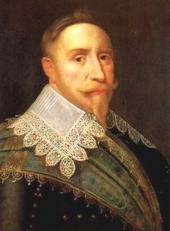Gustav II Adolf (9 December 1594 – 6 November 1632), widely known by the Latinized name Gustavus Adolphus and in Swedish sometimes as Gustav Adolf the Great, was King of Sweden from 1611 until his death in battle.
Charles IX of Sweden - father
Gustavus Adolphus was born in Stockholm as the oldest son of King Charles IX of Sweden of the Vasa dynasty and his second wife, Christina of Holstein-Gottorp. He inherited the throne upon his father's death at the age of seventeen in 1611, as well as an ongoing succession of dynastic disputes that periodically broke out in warfare with his Polish cousin, Sigismund III of Poland, who in the preliminary religious strife before the Thirty Years' War, was forced to let go of the throne of Sweden to Gustav's father.
Sigismund III of Poland
In a round of this dynastic dispute, he invaded Livonia when he was 31, beginning the Polish-Swedish War (1625–1629)
. His reign became famous from his actions a few years later when in June 1630 he invaded Germany, initiating Sweden's involvement in the ongoing Thirty Years' War
. Gustavus intervened on the anti-Imperial side, which at the time was losing to the Holy Roman Empire and its Catholic allies; the Swedish forces would quickly reverse that situation.
Maria Eleonora of Brandenburg - wife
He was married to Maria Eleonora of Brandenburg, the daughter of John Sigismund, Elector of Brandenburg, and chose the Prussian city of Elbing as the base for his operations in Germany. He died in the Battle of Lützen
in 1632. His involvement in the Thirty Years' War gave rise to the old prophecy that he was the incarnation of "the Lion of the North", or as it is called in German "Der Löwe von Mitternacht" (Literally: "The Lion from Midnight").
Military Command
Gustavus Adolphus was a main figure responsible for the great success of Sweden during the Thirty Years' War and led his nation to great prestige. As a general, Gustavus Adolphus is famous for employing mobile artillery on the battlefield, as well as very aggressive tactics, where attack was stressed over defense, and mobility and cavalry initiative were emphasized. He adopted much shallower infantry formations, with formations typically fighting in 5 or 6 ranks, occasionally supported at some distance by another such formation. These more linear deployments replaced traditional deep squares up to 50 ranks deep, used in other armies of the day. His musketeers were widely known for their firing accuracy and reload speed: three times faster than any contemporary rivals. Carl von Clausewitz and Napoleon Bonaparte considered him one of the greatest generals of all time. He was also renowned for his consistency of purpose and the amity of his troops.
When Gustavus Adolphus began his push into northern Germany in June-July 1630, he had just 4,000 troops. But he was soon able to consolidate the Protestant position in the north. Meanwhile, a Catholic army was laying waste to Saxony. Gustavus Adolphus met and defeated it at the Battle of Breitenfeld
in September 1631, in spite of the collapse of his Saxon allies. He then made plans for the invasion of the rest of the Holy Roman Empire.
Pikeman and Musketeer
In March 1632, Gustavus Adolphus invaded Bavaria. He forced the withdrawal of his Catholic opponents at the Battle of Rain
. This would mark the high point of the campaign. In the summer of that year, he sought a political solution that would preserve the existing structure of states in Germany, while guaranteeing the security of its Protestants. But achieving these objectives depended on his continued success on the battlefield.
Gustavus Adolphus was killed at the Battle of Lützen
, when, at a crucial point in the battle, he became separated from his troops while leading a cavalry charge into a dense smog of mist and gunpowder smoke.
Try the BEST MySpace Editor and MySpace Backgrounds at MySpace Toolbox !
